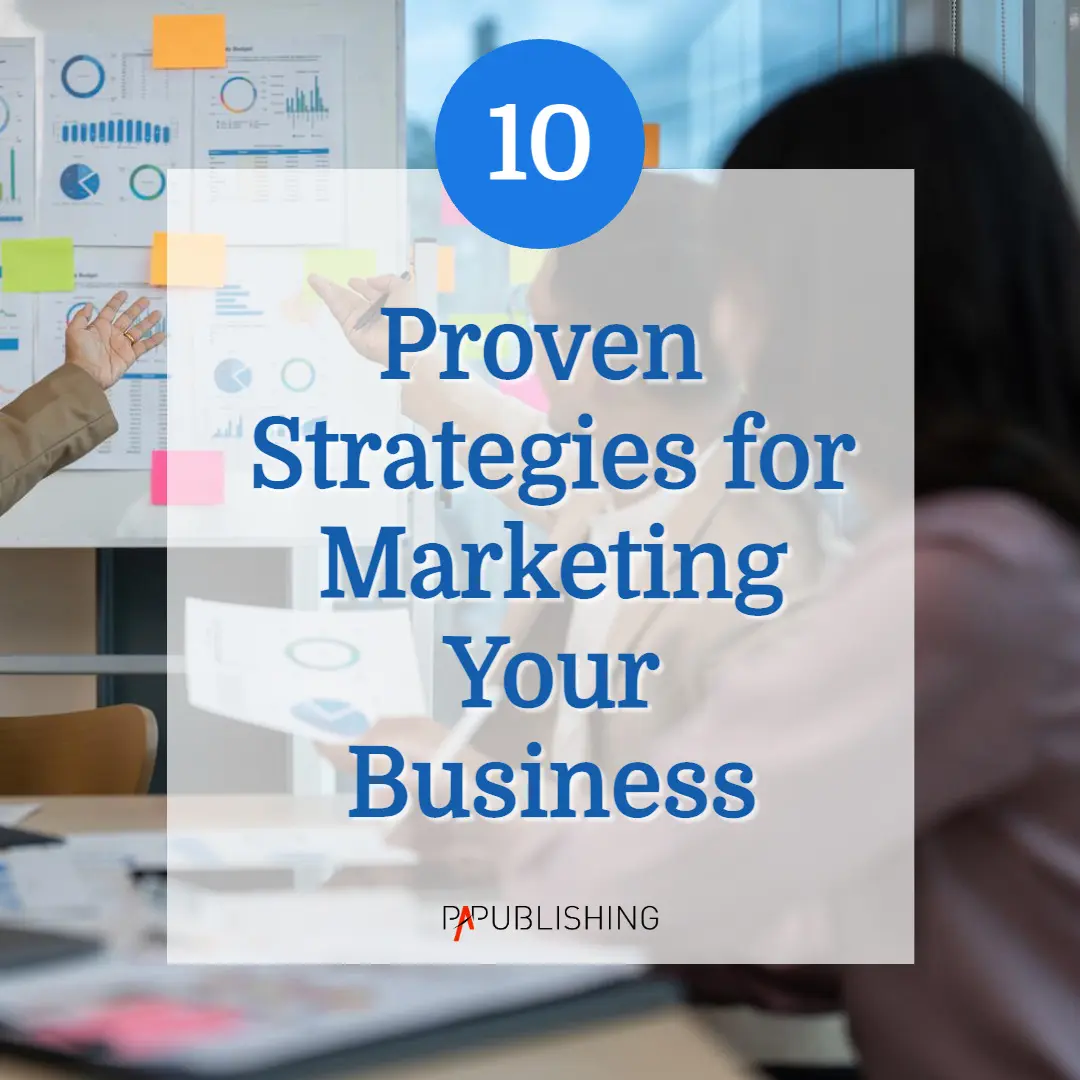Are you ready to take your business’s marketing strategy to the next level? With our top 10 proven strategies, you can effectively market your business and maximize its potential. We’ll show you how to use online and offline channels smartly, diversify content creation while staying true to your brand story, and select the metrics that matter most for tracking results. With this comprehensive guide of best practices, you’ll better understand modern marketing campaigns and be well on your way to becoming an expert in driving successful results. Let’s dive right in!
Online Marketing Strategies
Online marketing is essential for businesses to reach customers and build meaningful relationships. With the right expertise and strategies, you can drive measurable results that help your business stand out above its competitors. Understanding how different channels work together cohesively to improve your online marketing strategy is important. Use SEO-friendly content creation to ensure potential customers find you via search engine result pages (SERPs). Knowing which social media platforms are best suited for reaching your target audience is key; many successful organizations use multiple platforms, such as Twitter, Instagram, Facebook, LinkedIn, Pinterest, etc., with varying levels of focus based on their objectives. Once the content is created and established distribution methods are selected, it’s time to measure success with metrics like website visits or email open rates. Tracking these KPIs (key performance indicators) will help create refinements over time, allowing for maximum efficiency of campaign efforts to deliver better results.
Offline Marketing Strategies
Offline marketing is still an effective way to promote your business and drive sales. There are a few great strategies that you can use to ensure success when it comes to connecting with potential customers without the assistance of technology.
For starters, take into account the power of word-of-mouth advertising! Encourage current customers, employees, and acquaintances to spread the word about your business or services. Consider hosting in-person events such as seminars, classes, or workshops for related audiences, such as direct mailing samples of your products, giving away freebies at community events, or providing discounts for those who refer their friends. Additionally, print advertising doesn’t always have to be expensive – opt for options like flyers from local printers, which can often cost less than traditional media channels like television or radio ads. Lastly, keeping up with updating the physical faces of businesses like signs, whether it’s right outside retail storefronts or strategically placed advertisements, will help many people find out who you are and what value you bring to them/the marketplace – both locally and on a larger scale!
Diversifying Content Creation
Diversifying content creation is crucial for any marketing strategy. Different platforms to create and share your brand’s message can help you reach more people with various types of communication, from visuals to podcasts, i.e., long-form text posts on social media or blogs, infographics, videos, and audio signage. With the right combination of these various sources and tactics, you will have an efficient way to tell stories about your business that resonates well with customers and helps them better understand what sets your products apart.
Creating content in unique formats keeps followers engaged by allowing them to choose whatever type they prefer, whether it be visual cues such as photos, logos, or videos, which are increasingly popular across all social media channels, or interactive experiences such as questionnaires’ surveys, etc., diversifying ensures potential customers get the experience they want while learning more about who you are and what your business stands for. Furthermore, by implementing campaigns around key topics related to product launches, sale points, news/press releases, and more, when telling stories behind each product/service, consumers will build trust toward brands and develop an affinity towards them before making buying decisions.
Building Brand Story
Building a brand story is an essential part of any successful marketing campaign. A brand story puts a human face to your business and brings it alive. The identity you create and display to consumers will give them insight into who you are as a company or organization. Your brand story should be unique and evoke emotions; tell stories that compel people to engage with your product or service in ways they haven’t before.
Furthermore, ensure your brand messaging is consistent across all channels when constructing your story — online, print, television, etc. A strong message portrayed on social media isn’t effective if not repeated in valuable content you produce, such as digital media like blogs or videos, enlightening how much value customers gain from engaging with you! Moreover, focus on communicating benefits rather than features – by doing this, customers clearly understand what sets you apart from competitors and reinforce loyalty towards investing in only your services/products!
Overall creating content objects like stories and case studies can help potential buyers find more about who we are, providing a sense of trust & security for possible future investments; Brand Story building helps us create unforgettable experiences leaving repeat customers at the center while enhancing our presence & credibility.
Selecting the Right Metrics for Tracking
When marketing your business, selecting the right metrics is essential for gauging success and understanding where issues may arise. Measuring results accurately allows for optimal performance and greater return on investment (ROI). It’s vital to select key performance indicators (KPIs) that reflect the goals of your business to measure progress and get the desired outcome from any campaign.
Specific metrics will be better suited for particular businesses as every company has different objectives when it comes to its marketing campaigns. Common KPIs used by successful brands include search engine ranking, website traffic, conversions from landing pages or forms, clicks on links or ads, social media reach and engagement levels, revenue generated from each channel by product/service type, feedback surveys collected over time, etc. Utilizing multichannel tracking tools with the ability to collect this data can provide a more holistic picture of ROI based on the kind of campaign used. Metrics help identify areas for improvement, likely without spending too much additional time analyzing data manually.
The overall use of relevant, actionable metrics empowers marketers to play an active role in boosting sales significantly. They can easily monitor and evaluate tactics adopted by them while combining strategy with tactical execution through constantly measuring learning curves. Selecting purposeful measurements provides insights into specific activities leading up towards improved brand experience, eventually optimizing Sales & Revenue generation -all thanks to informed decision-making resulting from carefully analyzed analytics contributing significantly towards overall success rate.
How to Measure Success
Measuring success is essential to optimizing any marketing strategy. It helps marketers understand what’s working and how much the efforts are paying off in real-time. Various metrics, such as site traffic analysis, user engagement rates, customer loyalty figures, online reviews, etc., are available.
Companies of any size should look at tracking relevant data from across every available metric to get an accurate picture of their overall performance, as some metrics may overlap with one another regarding goal achievement rather than just stand-alone values. For example, you’ll want to measure web traffic numbers together with sales or conversion rates – if those two metrics increase together, then that’s a good sign your campaign is working well; vice versa; if either dips, then adjustments may need tweaking for better results. Social media engagement rate provides another vital source of intelligence indicating how customers interact and engage with brand messages on various networks, which gives further contextual insights into targeting effectiveness and attribution levels.
It is critical to track these regularly so informed decisions regarding budgeting allocations can be taken based on true performances rather than estimations only, allowing more profitable outcomes over time!
Utilizing Social Media Platforms
Utilizing social media platforms is a practical component of an effective marketing campaign. By creating and managing your business’s Facebook, Twitter, Instagram, LinkedIn, Pinterest, and YouTube accounts, you can reach and connect with potential customers in ways that weren’t possible before.
Satisfied customers are your walking advertisement acting as word-of-mouth ambassadors! When done right, social media strategies increase visibility and engagement, maximizing returns like no other channel and helping companies take their marketing efforts up a notch! With the right approach, these platforms help you build relationships with your target audience by providing them with cleverly crafted content—all while staying true to your brand story. Also, social media connections create more trust between your business and potential customers, eventually leading to more sales opportunities. Having a presence on social media also allows you to monitor how people respond positively and negatively to products/services – it’s invaluable information that gives insights into improving customer satisfaction leading to repeat purchases and new engagements from satisfied customers.
Leveraging Paid Advertising
Leveraging paid advertising is an effective way to market a business and maximize its potential. With the advanced targeting and tracking capabilities provided by Google Ads, social media platforms such as Instagram, Twitter, and Snapchat, or media-buying services like AdWords, you can target customers o become loyal consumers of your brand.
Creating ads that resonate with existing and prospective customers while integrating them into the wider marketing strategy is important when using these platforms. Paid advertising allows businesses to laser-focus conversations on customers within their target market without relying on organic search results, which are quite valuable yet usually have longer development times associated with them. This quicker response time for businesses pays dividends in increased customer growth over time.
Additionally, paid ad opportunities grant access to benefits such as additional metrics and data points gained through optimization tasks. Both small businesses and large fortune 500 companies strive for increased ROI numbers, heavily relying on manipulations of Cost Per Clicks (CPCs) tools built inside various best-in-line software solutions producing valuable insights promoted via smart metrics delivering faster than ever due to engineering advancements.
Optimizing Your Website for Conversions
Optimizing Your Website for Conversions is vital in any modern marketing campaign. By understanding user behavior on your website, you can create custom experiences that convert users into customers. One way to accomplish this is by creating an attractive landing page to encourage visitors to take action, such as signing up for newsletters or making purchases. Additionally, running A/B tests is essential as it allows you to compare two designs and collect valuable data on which generates the highest conversion rate.
Furthermore, optimizing website speed is key since slow loading times can significantly decrease conversions. This involves reducing your images’ file size and leveraging Google’s PageSpeed Insights tool to optimize your code according to best practices recommended by Google engineers. Finally, using Retargeting Ads will help remind potential buyers of their interest in your product or service after they have left your site without taking any action – thus boosting conversions further! Following these steps will help enhance customer experience and improve overall results from your marketing campaigns!
Automation and Artificial Intelligence in Marketing
In the 21st century, automation and artificial intelligence (AI) are becoming increasingly important in modern marketing practices. Automation tools can help streamline processes, boost efficiency, and eliminate tedious manual tasks like market research or crafting email campaigns. AI-based algorithms offer real-time insights into consumer behavior that can be used to refine targeting strategies and pinpoint areas for improvement. With these technological advances, marketers have unprecedented access to vast amounts of data they can use to their advantage when creating effective marketing plans. Better yet, new technologies make it easier for SMBs and startups to develop engaging content on social media platforms without having to dedicate large chunks of budget towards hiring personnel specifically devoted to the task. No matter your business’ size or industry background, automating marketing activities is an excellent way to improve your ROI while saving time—making it a Win/Win scenario all around!



